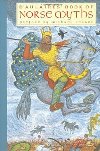|
D'Aulaires' Book of Norse Myths

Last updated Tuesday, December 7, 2010
Author: Ingri D'Aulaire
Date of Publication: 2005
ISBN: 159017125X
Grade Level: 5th (GLCs: Click here for grade level guidelines.)
Date(s) Used: Dec. 2010
Synopsis:
From Amazon.com:
The Norse myths are some of the greatest stories of all time. Weird monsters, thoroughly human gods, elves and sprites and gnomes, with grim giants nursing ancient grudges lurking behind—the mysterious and entrancing world of Norse myth comes alive in these pages thanks to the spellbinding storytelling and spectacular pictures of the incomparable d'Aulairse. In this classic book, the art of the Caldecott Award—winning authors of d'Aulaires' Book of Greek Myths, a longtime favorite of children and parent, reaches one of its pinnacles. It offers a way into a world of fantasy and struggle and charm that has served as inspiration for Marvel Comics and the Lord of the Rings.
| Note to readers: |
| • |
In the back there is a glossary of words and pronunciations, e.g."J" is pronounced like "Y," as in the first letter in the word "yes;" "Y" is pronounced like a long "ee", as in "sheep."
|
| • |
Part of J. R.R. Tolkien’s inspiration for Lord of the Rings was the stories of the Norse Gods.
|
| • |
Readers should skip the Preface and Introduction, and are encouraged to read the myths in the following order:
""The First Gods and Giants," "The Creation of the World," "The Creation of Man," "Yggdrasil, the World Tree," "Asgard, and the Aesir Gods," "Odin, the All-father," "Thor, the Thunder-god," "Loki, the God of the Jotun Race," "Loki's Monstrous Brood," "The Valkyries and Valhalla," "The Theft of Thor's Hammer," "The Death of Balder," "Loki's Punishment," "Ragnarokk, the Destiny of the Gods."
|
| • |
Background: The Norse or Norsemen are more commonly called Vikings, and from 800 to 1000 AD they terrorized all of Europe and North Africa as they used their ships to kill people, destroy cities and steal whatever they wanted. The Norse lived in Scandinavia, the countries of Norway, Sweden, Denmark, in northern Europe. They settled Iceland and Greenland, and some even came to parts of Canada about 500 years before Christopher Columbus. The Norse did NOT wear horned helmets- they were just depicted that way because the Christians they attacked thought they were devilish.
|
| Discussion topics for before reading: |
| • |
What do you know about Norsemen and/or Vikings?
|
| • |
Do you know where Scandinavia is, or where Sweden, Norway and Denmark are? (there should be a map of Europe or a globe in the classroom)
|
| • |
Have you every heard of Thor? What do you know about him? Have you ever heard of Loki? Do you know what a Valkyrie is?
|
| Discussion topics for during/after reading: |
| • |
Are there any stories you have heard that have similarities to the Norse myths we are reading?
|
| • |
Do any of the Norse Gods, creatures or stories show up in movies or video games you know?
|
| • |
Would you like to be a Viking? Why or why not?
|
| • |
Do modern-day soldiers or warriors share any of the same values that the Norse Gods value?
|
| • |
What is different about the Norse Gods and myths and other gods or myths you know? (e.g. the Norse Gods not only can die, Odin even knows how they will die- and yet, they fight anyway).
|
| Craft ideas: |
| • |
Make a holiday ornament of a Norse God. Draw and color one of the characters from the book. Cut the figure out and attach an ornament hook. For added difficulty, decorate both sides of the ornament.
|
| • |
Draw any scene from the Norse myths you read today. Or, create your own Norse myth from the Norse Gods you read about today, or draw a scene from your myth.
|
| • |
Make a “World Tree” mobile or draw the Yggdrasil, the World Tree. Use the front and back inside covers for inspiration for the world tree or your personal world tree. Make sure to have multiple worlds with different characters/rulers and power.
|
*Note: These craft ideas are just suggestions.
You can use them, but you don't have to use them.
You can expand upon them, or add your own twist.
Remember, though, that the focus of your time should
not be on the development and execution of a craft;
the focus should be on the read-aloud and the
enjoyment of the book!
|
